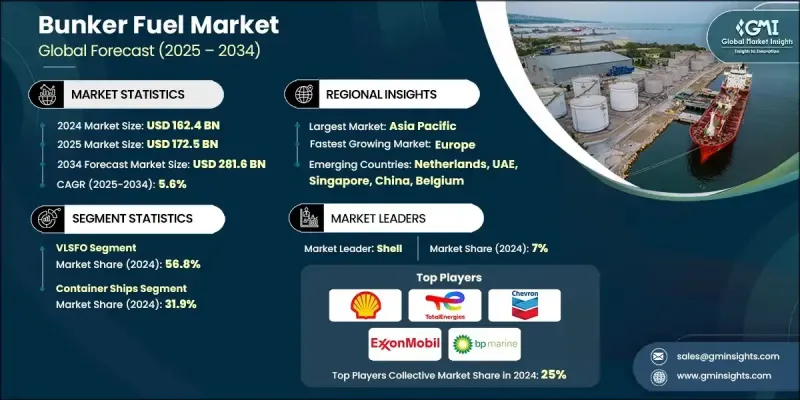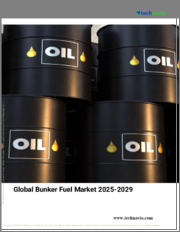
|
시장보고서
상품코드
1858874
벙커 연료 시장 : 시장 기회, 성장 촉진요인, 산업 동향 분석, 예측(2025-2034년)Bunker Fuel Market Opportunity, Growth Drivers, Industry Trend Analysis, and Forecast 2025 - 2034 |
||||||
세계의 벙커 연료 시장 규모는 2024년에 1,624억 달러로 평가되었고, CAGR 5.6%로 성장할 전망이며, 2034년에는 2,816억 달러에 이를 것으로 예측됩니다.

업계의 성장은 주로 해상 무역 증가, 선박 기술의 지속적인 진보, 연료 소비 효율의 개선에 의해 초래됩니다. 해운 사업이 보다 지속가능한 것이 되려고 노력하고 있는 가운데, 연료 EU 해사 규제와 같은 환경 규제의 강화에 의해 보다 깨끗한 연료원으로의 시프트가 현저해지고 있습니다. 이러한 규제는 해운 산업에서 이산화탄소 배출량을 줄이기 위한 것이고, 해운 업계는 환경 컴플라이언스와 탄소 실적를 줄이는 데 점점 더 많은 노력을 기울이고 있습니다. 보다 공기역학적 선체 설계 및 고급 추진 시스템과 같은 기술 혁신도 연료 효율에 기여하여 해상 운송의 운영 비용과 환경 영향을 줄이는 데 도움이 됩니다. 또한 해외 및 육상 탄화수소 탐사 활동이 확대됨에 따라 선박의 동력원과 항만 및 항해 운영에 필수적인 벙커 연료 수요가 계속 증가하고 있습니다. 기후 정책이 진전되고 배출량 감축이 중시되는 가운데 해운업계는 보다 깨끗한 대체연료로의 전환을 꾸준히 진행하고 있습니다.
| 시장 범위 | |
|---|---|
| 시작 연도 | 2024년 |
| 예측 연도 | 2025-2034년 |
| 시장 규모 | 1,624억 달러 |
| 예측 금액 | 2,816억 달러 |
| CAGR | 5.6% |
2024년 초저유황 연료유(VLSFO) 부문의 점유율은 56.8%였으며, 2034년까지 CAGR 7%로 성장이 예상됩니다. 이 부문의 성장을 이끌어내는 것은 환경에 악영향이 적은 저유황 연료로의 전환입니다. VLSFO는 선주에게 황산화물(SOx) 배출 감축의 이점을 제공하여 대기질 및 운항 효율 개선에 기여합니다. 또한 기존의 선박용 엔진과의 호환성도 확보되므로 대폭적인 개조를 필요로 하지 않고 보다 부드러운 이행이 가능합니다. 연료 효율 개선 및 엄격한 배출 기준 준수를 위한 지속적인 투자는 VLSFO 시장을 강화할 것으로 예측됩니다.
컨테이너선 부문은 2024년에 31.9%의 점유율을 차지했으며, 2025-2034년 CAGR 5.5%로 성장할 것으로 예측됩니다. 컨테이너 선박은 해운 업계에서 가장 큰 연료 소비자이기 때문에 고품질 벙커 연료에 대한 수요는 매우 중요합니다. 이 시장의 장점은 세계 무역의 지속적인 확대로 인한 곳이 크고 해상 운송의 필요성이 높아져 벙커 연료 소비도 증가하고 있습니다. 해운회사는 대규모 선대의 동력원으로서 벙커 연료에 크게 의존하고 있으며, 이 필수 연료원에 대한 수요는 앞으로도 계속될 것입니다.
미국의 벙커 연료 시장은 2024년에 86.5%의 점유율을 차지하였고, 56억 달러를 창출했습니다. 이 나라의 견고한 인프라는 국내 및 국제 무역량이 증가함에 따라 시장 역학을 크게 형성하고 있습니다. 항만의 인프라 정비 및 연료 공급 시스템의 강화로 연료 공급 업무가 간소화되었습니다. 또한, 선박용 연료의 유황 함유량 감소를 의무화하는 엄격한 규제가 업계 상황의 재구축에 중요한 역할을 하고 있습니다.
세계의 벙커 연료 시장에서 사업을 전개하는 주요 기업으로는 TotalEnergies, Chevron, Shell, ExxonMobil, Bunker Holding, bp, Hindustan Petroleum Corporation Limited, Gasnor, Repsol, Stena Metall, Gasum, Minerva Bunkering, Gunvor, Eagle LNG, KOREA LNG BUNKERING, Viva Energy, Bomin Bunker, Petrobras, Innospec 등이 있습니다. 경쟁력을 유지하기 위해 벙커 연료 시장의 각 회사는 제공하는 연료의 다양화, 특히 더 깨끗하고 지속 가능한 옵션을 늘려 세계 존재감을 높이는 데 주력하고 있습니다. 많은 기업들은 연료 효율을 향상시키고 새로운 환경 규제를 충족시키기 위해 연구개발에 투자하고 있습니다. 또한 장기적인 연료 계약을 확보하고 시장 점유율을 확대하기 위해 해운회사와 파트너십을 맺는 기업도 있습니다. 또, 벙커 연료 수요 증가에 대응할 수 있도록, 연료 저장이나 유통 네트워크 등의 인프라 능력을 확대하고 있는 기업도 있습니다.
자주 묻는 질문
목차
제1장 조사 방법 및 범위
제2장 주요 요약
제3장 업계 인사이트
- 생태계 분석
- 원재료 가용성 및 조달 분석
- 밸류체인에 영향을 주는 주요 요인
- 혁신
- 규제 상황
- 업계에 미치는 영향요인
- 성장 촉진요인
- 업계의 잠재적 위험 및 과제
- 성장 가능성 분석
- Porter's Five Forces 분석
- PESTEL 분석
- 새로운 기회 및 동향
- IoT 기술에 의한 디지털 전환
- 신흥 시장에 대한 침투
- 투자 분석 및 전망
제4장 경쟁 구도
- 서문
- 기업의 시장 점유율 분석 : 지역별
- 북미
- 유럽
- 아시아태평양
- 중동 및 아프리카
- 라틴아메리카
- 전략적 노력
- 경쟁 벤치마킹
- 전략적 대시보드
- 혁신 및 지속가능성의 정세
제5장 시장 규모 및 예측 : 제품별(2021-2034년)
- 주요 동향
- HSFO
- VLSFO
- MGO
- LNG
- 기타
제6장 시장 규모 및 예측 : 선종별(2021-2034년)
- 주요 동향
- 컨테이너선
- 유조선
- 화물선
- 크루즈선
- 기타
제7장 시장 규모 및 예측 : 지역별(2021-2034년)
- 주요 동향
- 북미
- 미국
- 캐나다
- 유럽
- 독일
- 영국
- 네덜란드
- 스페인
- 벨기에
- 아시아태평양
- 중국
- 인도
- 일본
- 한국
- 호주
- 싱가포르
- 중동 및 아프리카
- 아랍에미리트(UAE)
- 사우디아라비아
- 남아프리카
- 모로코
- 라틴아메리카
- 브라질
- 아르헨티나
제8장 기업 프로파일
- Bomin Bunker
- BP
- Bunker Holding
- Chevron
- Minerva Bunkering
- Eagle LNG
- EVOL LNG
- ExxonMobil
- Gasnor
- Gasum
- Gunvor
- Hindustan Petroleum Corporation Limited
- Innospec
- KOREA LNG BUNKERING
- Shell
- SHV Energy
- TotalEnergies
- Petrobras
- Repsol
- Stena Metall
- Viva Energy
The Global Bunker Fuel Market was valued at USD 162.4 billion in 2024 and is estimated to grow at a CAGR of 5.6% to reach USD 281.6 billion by 2034.

The growth of the industry is primarily driven by an increase in seaborne trade, ongoing advancements in vessel technology, and improvements in fuel consumption efficiency. As shipping operations strive to become more sustainable, there is a notable shift toward cleaner fuel sources, driven by tighter environmental regulations like the FuelEU Maritime regulation. These regulations are aimed at reducing carbon emissions within the shipping industry, which is increasingly focused on environmental compliance and reducing its carbon footprint. Technological innovations, such as more aerodynamic hull designs and advanced propulsion systems, also contribute to fuel efficiency and help reduce the operational costs and environmental impact of maritime transportation. Additionally, expanding offshore and onshore hydrocarbon exploration activities continue to drive demand for bunker fuel, which is essential for powering vessels and enabling port and voyage operations. With climate policies evolving and an increased emphasis on reducing emissions, the shipping industry is steadily transitioning to cleaner fuel alternatives.
| Market Scope | |
|---|---|
| Start Year | 2024 |
| Forecast Year | 2025-2034 |
| Start Value | $162.4 Billion |
| Forecast Value | $281.6 Billion |
| CAGR | 5.6% |
In 2024, the very low sulfur fuel oil (VLSFO) segment held a 56.8% share and is expected to grow at a CAGR of 7% through 2034. This segment's growth is driven by the transition to fuels with lower sulfur emissions that cause less environmental harm. VLSFO offers shipowners the benefit of reduced sulfur oxide (SOx) emissions, contributing to improved air quality and operational efficiency. It also ensures compatibility with existing marine engines, enabling a smoother transition without the need for significant retrofitting. Ongoing investments to improve fuel efficiency and comply with stringent emissions standards are expected to bolster the VLSFO market.
The container ships segment held a 31.9% share in 2024 and is anticipated to grow at a CAGR of 5.5% from 2025 to 2034. Container ships are some of the largest fuel consumers in the maritime industry, making the demand for high-quality bunker fuel crucial. This market dominance is largely due to the continuous expansion of global trade, which drives the need for increased maritime transportation and, consequently, greater bunker fuel consumption. Shipping companies, relying heavily on bunker fuel to power large fleets, will continue to drive demand for this essential fuel source.
U.S. Bunker Fuel Market held a share of 86.5% in 2024, generating USD 5.6 billion. The country's robust infrastructure, coupled with an increasing volume of domestic and international trade, has significantly shaped its market dynamics. Infrastructure improvements at ports and enhanced fuel distribution systems have streamlined fuel supply operations. Furthermore, stringent regulations mandating lower sulfur content in marine fuels have played a key role in reshaping the industry's landscape.
Key players operating in the Global Bunker Fuel Market include TotalEnergies, Chevron, Shell, ExxonMobil, Bunker Holding, bp, Hindustan Petroleum Corporation Limited, Gasnor, Repsol, Stena Metall, Gasum, Minerva Bunkering, Gunvor, Eagle LNG, KOREA LNG BUNKERING, Viva Energy, Bomin Bunker, Petrobras, and Innospec. To maintain a competitive edge, companies in the bunker fuel market are focusing on enhancing their global presence by diversifying their fuel offerings, particularly with cleaner, more sustainable options. Many are investing in research and development to improve fuel efficiency and meet new environmental regulations. Some companies are also forging partnerships with shipping firms to secure long-term fuel contracts and increase market share. Others are expanding their infrastructure capabilities, such as fuel storage and distribution networks, to ensure they can meet the growing demand for bunker fuel.
Table of Contents
Chapter 1 Methodology & Scope
- 1.1 Research design
- 1.2 Market estimates & forecast parameters
- 1.3 Forecast calculation
- 1.4 Data sources
- 1.4.1 Primary
- 1.4.2 Secondary
- 1.4.2.1 Paid
- 1.4.2.2 Public
- 1.5 Market definitions
Chapter 2 Executive Summary
- 2.1 Industry synopsis, 2021 - 2034
- 2.2 Business trends
- 2.3 Product trends
- 2.4 Vessel type trends
- 2.5 Regional trends
Chapter 3 Industry Insights
- 3.1 Industry ecosystem analysis
- 3.1.1 Raw material availability & sourcing analysis
- 3.1.2 Key factors affecting the value chain
- 3.1.3 Disruptions
- 3.2 Regulatory landscape
- 3.3 Industry impact forces
- 3.3.1 Growth drivers
- 3.3.2 Industry pitfalls & challenges
- 3.4 Growth potential analysis
- 3.5 Porter's analysis
- 3.5.1 Bargaining power of suppliers
- 3.5.2 Bargaining power of buyers
- 3.5.3 Threat of new entrants
- 3.5.4 Threat of substitutes
- 3.6 PESTEL analysis
- 3.6.1 Political factors
- 3.6.2 Economic factors
- 3.6.3 Social factors
- 3.6.4 Technological factors
- 3.6.5 Legal factors
- 3.6.6 Environmental factors
- 3.7 Emerging opportunities & trends
- 3.7.1 Digital transformation with IoT technologies
- 3.7.2 Emerging market penetration
- 3.8 Investment analysis & future outlook
Chapter 4 Competitive Landscape, 2025
- 4.1 Introduction
- 4.2 Company market share analysis, by region, 2024
- 4.2.1 North America
- 4.2.2 Europe
- 4.2.3 Asia Pacific
- 4.2.4 Middle East & Africa
- 4.2.5 Latin America
- 4.3 Strategic initiatives
- 4.4 Competitive benchmarking
- 4.5 Strategic dashboard
- 4.6 Innovation & sustainability landscape
Chapter 5 Market Size and Forecast, By Product, 2021 - 2034 (USD Million)
- 5.1 Key trends
- 5.2 HSFO
- 5.3 VLSFO
- 5.4 MGO
- 5.5 LNG
- 5.6 Others
Chapter 6 Market Size and Forecast, By Vessel Type, 2021 - 2034 (USD Million)
- 6.1 Key trends
- 6.2 Container ships
- 6.3 Tankers
- 6.4 Cargo vessels
- 6.5 Cruise ships
- 6.6 Others
Chapter 7 Market Size and Forecast, By Region, 2021 - 2034 (USD Million)
- 7.1 Key trends
- 7.2 North America
- 7.2.1 U.S.
- 7.2.2 Canada
- 7.3 Europe
- 7.3.1 Germany
- 7.3.2 UK
- 7.3.3 Netherlands
- 7.3.4 Spain
- 7.3.5 Belgium
- 7.4 Asia Pacific
- 7.4.1 China
- 7.4.2 India
- 7.4.3 Japan
- 7.4.4 South Korea
- 7.4.5 Australia
- 7.4.6 Singapore
- 7.5 Middle East & Africa
- 7.5.1 UAE
- 7.5.2 Saudi Arabia
- 7.5.3 South Africa
- 7.5.4 Morocco
- 7.6 Latin America
- 7.6.1 Brazil
- 7.6.2 Argentina
Chapter 8 Company Profiles
- 8.1 Bomin Bunker
- 8.2 BP
- 8.3 Bunker Holding
- 8.4 Chevron
- 8.5 Minerva Bunkering
- 8.6 Eagle LNG
- 8.7 EVOL LNG
- 8.8 ExxonMobil
- 8.9 Gasnor
- 8.10 Gasum
- 8.11 Gunvor
- 8.12 Hindustan Petroleum Corporation Limited
- 8.13 Innospec
- 8.14 KOREA LNG BUNKERING
- 8.15 Shell
- 8.16 SHV Energy
- 8.17 TotalEnergies
- 8.18 Petrobras
- 8.19 Repsol
- 8.20 Stena Metall
- 8.21 Viva Energy




















